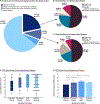Bedsharing in Early Childhood: Frequency, Partner Characteristics, and Relations to Sleep
- PMID: 33988085
- PMCID: PMC8522355
- DOI: 10.1080/00221325.2021.1916732
Bedsharing in Early Childhood: Frequency, Partner Characteristics, and Relations to Sleep
Abstract
Bedsharing (sharing a bed with others during sleep) in early childhood (3-5 years old) is common across Western and non-Western societies alike. Though prior work indicates that bedsharing may relate to impairments in child sleep quantity or quality, the majority of studies conducted in young children are limited to parent-child bedsharing and rely almost exclusively on caregiver reports to measure child sleep. Here, the authors endeavored to gain further insights into the diversity of bedsharing practices among children in the United States, including how different bedsharing partners (caregivers, siblings) might impact actigraphy-derived measures of children's sleep. Using a sample of 631 children ages 2:9 to 5:11 years, we found that over 36% of children bedshared in some form overnight, with approximately 22% bedsharing habitually. In a subset of children for whom actigraphy measures were collected (n = 337), children who bedshared habitually (n = 80) had significantly shorter overnight sleep, later sleep and wake times, and longer naps than solitary sleepers (n = 257), even when controlling for socioeconomic status. Despite supplementing their shorter overnight sleep with longer naps, habitually bedsharing children had significantly shorter 24-hr sleep time than did solitary sleepers, though differences in sleep efficiency were nonsignificant for all sleep periods. Additionally, sleep efficiency, onset latency, and duration did not differ between children who habitually bedshared with siblings versus those who habitually bedshared with parents. The present results add to prior work examining family contextual correlates of sleep differences in early childhood and provide a more objective account of relations between bedsharing and child sleep.
Keywords: Bedsharing; co-sleeping; early childhood; siblings; sleep.
Conflict of interest statement
Figures




Similar articles
-
Maternal sleep and arousals during bedsharing with infants.Sleep. 1997 Feb;20(2):142-50. doi: 10.1093/sleep/20.2.142. Sleep. 1997. PMID: 9143074
-
Bedsharing among breastfeeding physicians: Results of a nationwide survey.PLoS One. 2024 Aug 1;19(8):e0305625. doi: 10.1371/journal.pone.0305625. eCollection 2024. PLoS One. 2024. PMID: 39088472 Free PMC article.
-
Women Who Bedshare More Frequently at 14 Weeks Postpartum Subsequently Report Longer Durations of Breastfeeding.J Midwifery Womens Health. 2018 Jul;63(4):418-424. doi: 10.1111/jmwh.12753. Epub 2018 May 25. J Midwifery Womens Health. 2018. PMID: 29800503
-
Why babies should never sleep alone: a review of the co-sleeping controversy in relation to SIDS, bedsharing and breast feeding.Paediatr Respir Rev. 2005 Jun;6(2):134-52. doi: 10.1016/j.prrv.2005.03.006. Paediatr Respir Rev. 2005. PMID: 15911459 Review.
-
Bedsharing: toward a more holistic approach in research and practice.Holist Nurs Pract. 2007 Jan-Feb;21(1):19-25. doi: 10.1097/00004650-200701000-00005. Holist Nurs Pract. 2007. PMID: 17167328 Review.
Cited by
-
Contributions of memory and brain development to the bioregulation of naps and nap transitions in early childhood.Proc Natl Acad Sci U S A. 2022 Nov;119(44):e2123415119. doi: 10.1073/pnas.2123415119. Epub 2022 Oct 24. Proc Natl Acad Sci U S A. 2022. PMID: 36279436 Free PMC article.
-
Pediatric sleep electrophysiology: Using polysomnography in developmental cognitive neuroscience.Dev Cogn Neurosci. 2025 Jun;73:101562. doi: 10.1016/j.dcn.2025.101562. Epub 2025 Apr 29. Dev Cogn Neurosci. 2025. PMID: 40319672 Free PMC article. Review.
-
Associations of preschool reactive bed-sharing with sociodemographic factors, sleep disturbance, and psychopathology.Child Adolesc Psychiatry Ment Health. 2023 May 17;17(1):62. doi: 10.1186/s13034-023-00607-w. Child Adolesc Psychiatry Ment Health. 2023. PMID: 37198711 Free PMC article.
-
Bedsharing sleep characteristics in children with mild sleep-disordered breathing.J Clin Sleep Med. 2025 Feb 1;21(2):237-247. doi: 10.5664/jcsm.11352. J Clin Sleep Med. 2025. PMID: 39302128 Clinical Trial.
-
Sleep insufficiency and bedtime irregularity in children with ADHD: A population-based analysis.Sleep Med. 2024 Sep;121:117-126. doi: 10.1016/j.sleep.2024.06.015. Epub 2024 Jun 15. Sleep Med. 2024. PMID: 38959718 Free PMC article.
References
-
- Ball Helen L. (2006). Caring for twin infants: sleeping arrangements and their implications. Evidence Based Midwifery, 4(1), 10–16.
-
- Ball Helen Louise. (2006). Night-time infant care: cultural practice, evolution, and infant development. In Childrearing and infant care issues : a cross-cultural perspective (pp. 47–61). Melbourne: Nova Science.
-
- Berzofsky M, Smiley-McDonald H, Moore A, & Krebs C (2014). Measuring Socioeconomic Status (SES) in the NCVS: Background, Options, and Recommendations. Bureau of Justice Statistics, U.S. Department of Justice, (0213170), 65. 10.1007/BF03061070 - DOI
MeSH terms
Grants and funding
LinkOut - more resources
Full Text Sources
Other Literature Sources
